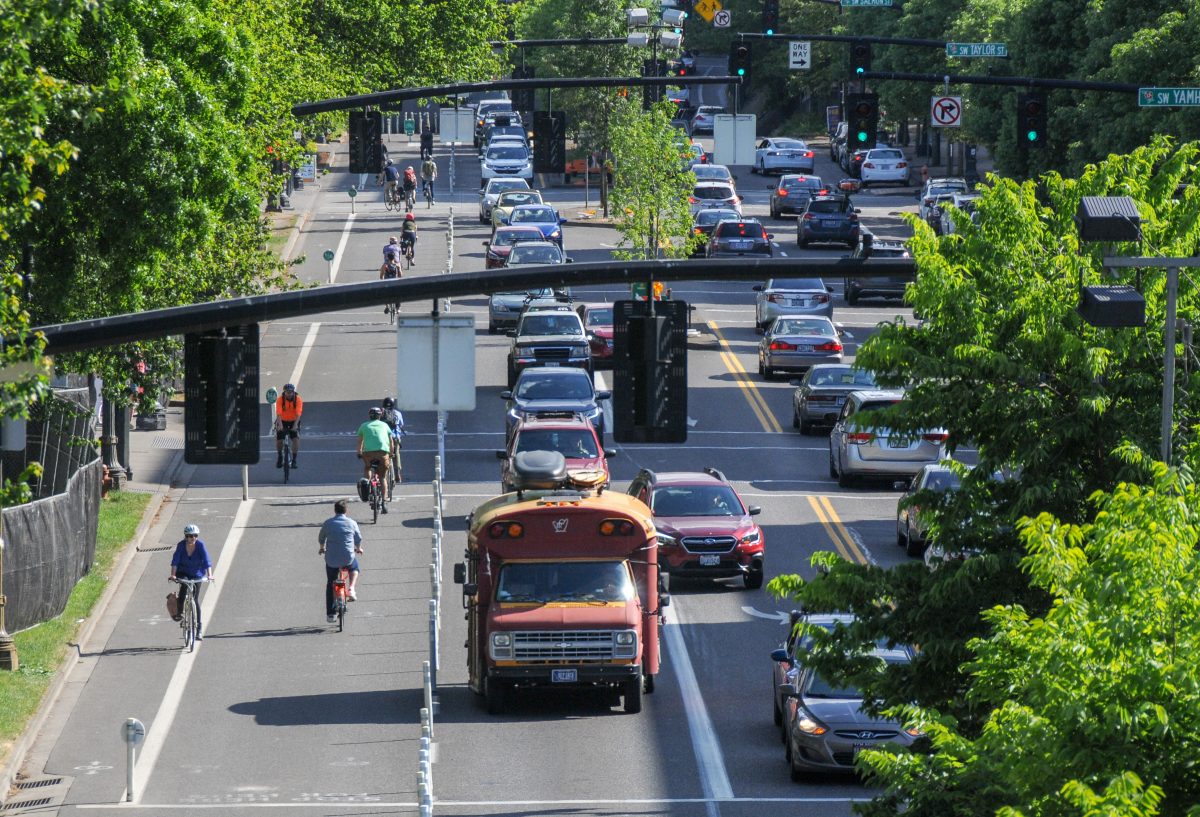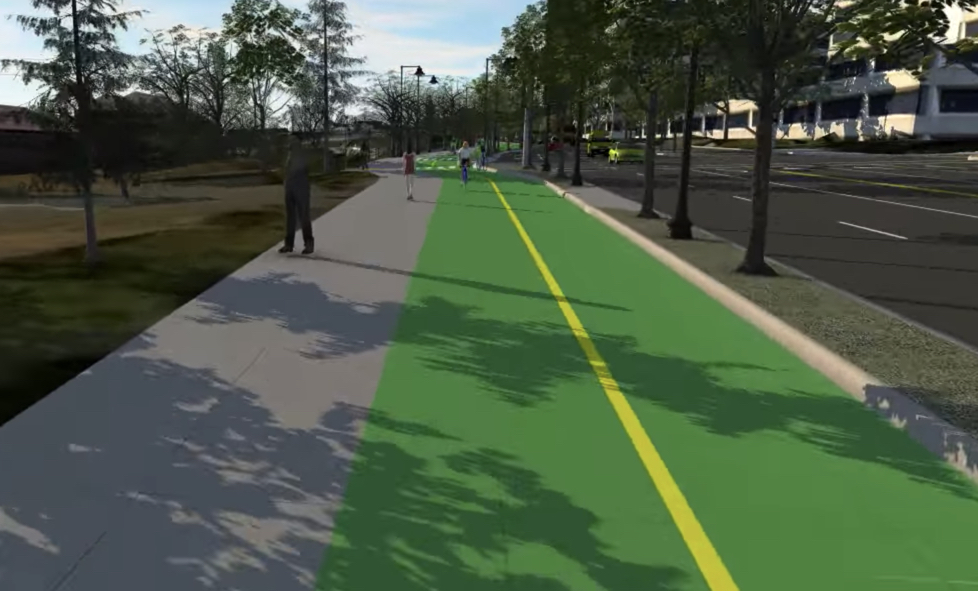
(Photo: Jonathan Maus)
“The Mayor wants one of these options to move forward [and] is interested in Option B.” — Michael Cox, Deputy Chief of Staff and Director of Communications for Mayor Ted Wheeler
Now in its fourth year as a seasonal street oasis for vulnerable road users, the talks about making Better Naito permanent are heating up.
This past winter, the Portland Bureau of Transportation commissioned a private consulting firm to develop a report (below) with conceptual designs for a capital project that would replace the temporary plastic delineator wands and paint striping that exist today on Naito Parkway’s northbound lanes from SW Main to NW Couch with a permanent, 20-foot wide path for bicycling, walking, and other uses.
This is the first time the report has been made public. We received a copy of it from Mayor Ted Wheeler’s Deputy Chief of Staff and Director of Communications Michael Cox after hearing about from various sources. Here’s the report:
[pdf-embedder url=”https://bikeportland.org/wp-content/uploads/2018/05/BetterNaito-180226-TM-Summary-Rev2-1.pdf” title=”BetterNaito-180226-TM-Summary-Rev2 (1)”]
The report was completed by David Evans and Associates (DEA) in late February and it offers three options with detailed cost estimates for each one. The three options outline ways to fit a 20-foot wide path for walking/rolling (eight feet) and two-way biking (12 feet) along northbound Naito Parkway. The current configuration is 16-feet wide and uses space of the bike lane (five feet) and one standard vehicle lane (11-feet).
Cost estimates range from $3.4 million to $5.3 million.
Here are the options in more detail:
Option A places the cycle track and sidewalk behind the existing curb to minimize impacts to traffic on SW Naito Pkwy. This maintains both northbound auto lanes, but has the greatest impact on Waterfront Park. ($5.3 million)
Option B balances Options A and C by retaining 2 northbound auto lanes south of SW Morrison St, but removing 1 lane to the north. This balances the competing needs to maintain traffic and avoid impacts to Waterfront Park. ($3.9 million)
Option C removes 1 northbound auto lane and places the cycle track and sidewalk adjacent to the roadway to minimize impacts to Waterfront Park. This retains the maximum number of trees and park area, but does not address stakeholder concerns about queuing or travel time delays. ($3.4 million)
And here’s a comparison of costs and other elements:

(Graphic: David Evans and Associates)
Inherent in all these options seems to be a reluctance to significantly impact driving. We see phrases like, “to minimize impacts to traffic,” “balances the competing needs to maintain traffic” and “stakeholder concerns about… travel time delays.” Also note the intention to maintain two standard vehicle lanes all the way to Morrison, a major connection to the I-5 freeway. Option A and B retain the two lanes that exist today.
It’s unclear where this concern for driving comes from given that feedback around Better Naito has been overwhelmingly positive. The city has heard opposition to the project from the Portland Business Alliance, whose spokesperson told The Oregonian on May 9th that, “We continue to be concerned about the impacts of Better Naito.” Michael Cox in the Mayor’s office told us the PBA wasn’t involved in developing these proposals. (See update below for new statement from PBA.)

(Graphic: David Evans and Associates, Tex: BikePortland)
The focus to “maintain traffic” on Naito is also interesting because PBOT themselves has pushed the narrative that Better Naito causes very minimal delays for drivers. Their analysis (detailed in the 2017 Better Naito report) shows that the reconfiguration of lanes results in about a 90-second increase in driving times during peak hours. The extra space for cycling and walking (a.k.a. traffic) also attracts more — and safer, healthier, cleaner, and more efficient — non-motorized trips. Last year PBOT counted more than 12,000 people walking on Better Naito in just one day during the Waterfront Blues Festival. During the five-month period it was installed in 2017, there were 393,173 one-way trips by people bicycling.
Advertisement
“The position of Better Block is for PBOT to take the current seasonal configuration and make the minimal improvements needed to keep it up year-round, instead of spending millions on a full capital rebuild of Naito Parkway.”
— Better Block PDX
Related and also noteworthy is that each option currently on the table requires right-of-way acquisition from Waterfront Park — including tree removals. The options range from taking nearly an acre (42,000 feet) and 40 trees out of the park in Option A, to five tree removals and 1,000 square feet in Option C. This section of Naito is very wide at 73-feet from curb-to-curb. It’s not clear why none of the options solely uses the existing roadway. A “bike project” that takes any trees and/or space away from Waterfront Park could be a public relations catastrophe not just for Mayor Wheeler and PBOT, but for cycling in general.
I asked Michael Cox from Wheeler’s office about this potential for opposition to park impacts. “This question will obviously feature as part of our outreach strategy and we will listen to concerns raised,” he replied via email this morning. Asked why there wasn’t a “no parks impact” option in the report, Cox said, “We’re looking at all the options, and Option C is in some ways similar to the seasonal configuration. The strategy outlined in the report, based on our request, is how to make it permanent.”
If one of these proposals moves forward and the City prepares to cut into the park, they’d be smart to refer to the 2003 Waterfront Park Master Plan which envisioned, “a new sidewalk along Naito Parkway will be 6–8′ wide through the full length of the park.”
Cox says while the Mayor has signaled a desire to move forward, he hasn’t made any final decisions. “The Mayor wants one of these options to move forward [and] is interested in Option B; but has asked PBOT to do additional outreach work with the neighboring community and ensure the engineering is sound and the cost estimates are accurate or refined.”

(Image: PBOT video still)
Looming over this project (and giving it momentum) is the already planned and funded project currently moving forward on Naito Parkway directly to the south. That project will include a full road rebuild between SW Harrison and Jefferson (Hawthorne Bridge) that will come with a 20-foot wide physically separated path. In their report, David Evans and Associates said this facility, “will function similarly” to the options to replace Better Naito.
While that project to the south will require some removal of vegetation, it’s not Waterfront Park — an iconic and beloved piece of land that sits on a former highway.
When former Mayor Charlie Hales proposed the idea of a permanent Better Naito in 2016, he said, “What if we just took that east lane on Naito and went ahead and made it into a bikeway? We really don’t need all those lanes.”
Better Block PDX, the group that piloted Better Naito in 2015 and then handed it over to PBOT in 2017, does not think it’s necessary to impact Waterfront Park. In a statement provided to BikePortland in late March (before this report was available), the group said, “Because we have such limited funds and resources as a City and some areas of town face huge hurdles just having basic safe streets, the position of Better Block is for PBOT to take the current seasonal configuration and make the minimal improvements needed to keep it up year-round, instead of spending millions on a full capital rebuild of Naito Parkway.”
The City of Portland was not in contact with Better Block PDX during the development of the DEA report.
We confirmed this morning that Better Block reached out to the Mayor’s office and Cox said, “We will engage them on the issue.” As for the Portland Business Alliance (who haven’t responded to our request for comment), Cox said they were sent a copy of the report just this week.
If this issue heats up soon, Wheeler could find himself in a powerful position. Not only does Wheeler still control of all the bureaus (he takes them during budget talks and hasn’t doled them back out yet); but both Parks and Transportation are without directors at the moment. Parks Director Mike Abbaté and PBOT Director Leah Treat have both resigned in recent weeks.
The next step in Better Naito’s future is a public outreach process. As we reported earlier this month, PBOT sees the opportunity to update Naito through the Central City in Motion project. The first chance to weigh in on these three options for a permanent Better Naito will be on June 4th when the City launches an online open house for that project.
CORRECTION, 1:57 pm: PBOT analysis shows a 90-second increase in driving times during the Better Naito installation, not a reduction, as I initially wrote. That was a typo/mistake and I regret any confusion it might have caused.)
UPDATE, 5:50 pm: Sandra McDonough, president and CEO of the Portland Business Alliance, has responded to our request for comment.
“The Alliance has long supported transportation solutions that ensure safe mobility for vehicles, bicyclists and pedestrians throughout the city. Naito Parkway is a location that must balance the needs of each of these modes; we are encouraged that the city has developed options to provide a permanent bike path in a portion of the Tom McCall Waterfront Park. This option appears to best accommodate all modes, and ensure the needs of all transportation system users are met by minimizing vehicle congestion and providing a truly protected bike path that will complement the planned bike path south of the Hawthorne Bridge. This proposal has the potential to be a win-win solution, and we look forward to continuing to work with the city and other stakeholders on a permanent plan that provides safety, accessibility and mobility for those who walk, ride and drive.”
— Jonathan Maus: (503) 706-8804, @jonathan_maus on Twitter and jonathan@bikeportland.org
Never miss a story. Sign-up for the daily BP Headlines email.
BikePortland needs your support.

